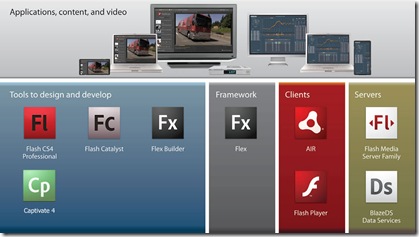Adobe Flash has evolved considerably since Macromedia Flash was used to create animations and develop and run interactive Web-based content. According to the current developers, the Adobe Flash Platform is
an integrated set of technologies surrounded by an established ecosystem of support programs, business partners, and enthusiastic user communities. Together, they provide everything you need to create and deliver the most compelling applications, content, and video to the widest possible audience.
The Flash Platform combines tools, an open source framework, ubiquitous clients, and scalable servers (see Table 1).
Table 1 Components of the Flash Platform
| Application Type | Technology |
| Runtime Environment | Flash Player |
| Flash Professional | |
| Authoring Tools | Flex |
| Flash Catalyst | |
| Flash Media Server | |
| Flash Server | BlazeDS |
| LiveCycle DS |
The environment enables content developers create applications and content from prototype to deployment in an integrated framework (see Figure 1).
In the context of Flash-based authoring tools like Adobe Captivate, the platform enables e-learning content authors to rapidly and efficiently design, develop and implement Web-based learning applications including:
- Screen recording and demos
- Software simulations
- Scenario-based training
- Presentations
- Quizzes
- Podcasts
- Screencasts
I have written about the pros and cons of Captivate in previous blog articles so I don’t intend to go over the same old ground again, but you can find out more by clicking here.
________________
References:
Adobe Website: http://www.adobe.com
--






3 comments:
I would also add that with Flash you can create Flash Lite applications. These can be delivered on mobile phones that have a Flash Lite player installed. Hopefully, with Flash Lite being pre-installed on more and more mobile phones it will have a positive impact on the implementation of m-learning.
Thanks for contributing Jeff.
A tricky one... I thought long and hard before omitting Flash Lite from yesterday's piece and ultimately decided to not include the technology for two reasons:
1. The original question was about Flash and Captivate
2. At the moment, I have concerns about Flash Lite's ability be an effective means of delivering m-learning.
I want assert that I think Flash is a very effective technology, and generally is an effective means to design, develop and deliver online learning. But (there's always a but) known issues concerning inconsistency in performance across a range of devices mitigate against the technology being a totally effective medium for m-learning content.
I've posted about this in a little more detail here: http://elearningcurve.blogspot.com/2009/02/no-flash-on-iphone-im-cool-with-that.html but I am certainly interested to hear your views on the subject.
Michael
--
Flash Lite absolutely is not there yet for m-learning. I was being very optimistic in my prior post. I think one of the biggest challenges for m-learning is the cross platform issue. Here is a post I wrote about iPhones, Blackberries and Flash Lite also addressing this - http://minutebio.com/blog/?p=51
I am optimistic that one day if not Flash Lite, some other entity will be universally on all devices and move m-learning forward. Who knows when that day will come?
Also, here is a resource for creating mobile content with Captivate- http://help.adobe.com/en_US/DeviceCentral/2.0_UsingDeviceCentral/WS48CF5DC4-3C1E-40d0-8522-F440275E2385.html
I am still on Captivate 2, but I believe in later versions (3&4) you can publish for Flash Lite directly from Captivate.
Thanks
Post a Comment